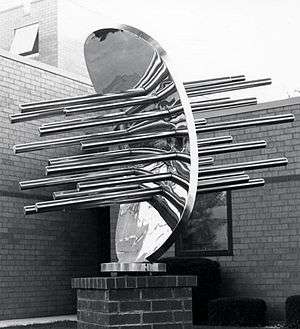Deflected Jets
 | |
| Artist | Guido Peter Brink |
|---|---|
| Year | 1988 |
| Dimensions | 350 cm × 89 cm × 89 cm (136 in × 35 in × 35 in) |
| Location | Milwaukee |
| 42°58′49.42″N 88°01′04.83″W / 42.9803944°N 88.0180083°W | |
Deflected Jets is a public artwork by American artist Guido Peter Brink located on the Fire Engine Company #29 grounds, which is at 3529 South 84th Street in Milwaukee, Wisconsin, United States. Brink’s 1988 Deflected Jets consists of a stainless steel abstract form atop a red brick base. The base holds a placard on it. Altogether, the piece measures to approximately 136 x 35 x 35 in.
Description
Guido Peter Brink’s artwork outside of the Milwaukee Fire Department, Fire Engine Company #29 is made up of polished stainless steel with a red brick base. It depicts jets of water piercing and being repelled by a shield.[1]The sculpture’s stainless steel portion is approximately 7’6” in height, and the brick is 3’10” high. A plaque on the brick base reads, “Deflated Jets by Guido Brink/Dedicated to the Guardians of Public Safety/The Milwaukee Fire Department”
Historical information
“Deflected Jets” was created as part of the Milwaukee Arts Board Percent for Art program.[1] The program began in 2000 and requires that 1% of the total budgeted construction for projects exceeding $5000 be applied to public art.[2] Many of the Percent for Art works placed outside fire stations have been met with very little enthusiasm by the firefighters who work there. This is due to overly realistic depictions of the firefighters’ work. Brink’s piece is an exception. “Deflected Jets lyrically captures the spirit of a firefighter’s commitment to the community. By creating a highly polished stainless steel sculpture of a shield and jets, which represent the water used by the firefighters and the courage they display, the artist gives the public the best in artistic imagination and craftsmanship.”[3]
Artist
Guido Peter Brink was born in Düsseldorf in 1913, and as a child, worked at his uncle’s stained glass studio. After apprenticing for three years, he attended the State Academy of Fine Arts in Düsseldorf from 1934-39. Here he was very inspired by the work of Paul Klee. Being drafted immediately upon graduation, Brink fought at the Russian front for the next few years. After the war ended, Brink became a landscape painter and emigrated to New York City with his wife Ello. Shortly after, they moved to Milwaukee for Brink to pursue stained glass work. Here he worked at Conrad Schmitt Studios, and eventually became a faculty member of the Layton School of Art. When the school closed in 1974, Brink delved into three-dimensional work, taking advantage of Milwaukee’s great wealth of fabricating and manufacturing plants. He became an artist in residence at Super Steel Products Corporation, and would stay there for more than 20 years.[4]“His works seem to be influenced by the experience of growing up between two world wars in the battlegrounds of Europe. He sought mental equilibrium in torn world.”[5]
Brink’s work can be found in public and private collections throughout the world, including at UW-Milwaukee outside of Lapham Hall, and in the Tory Folliard Gallery in Milwaukee’s Third Ward.[6]
See also
References
- 1 2 , SIRIS.
- ↑ Milwaukee County Percent for Art guidelines
- ↑ Buck, Diane M., Outdoor Sculpture in Milwaukee; A Cultural and Historical Guidebook., The State Historical Society of Wisconsin. 1995.
- ↑ Buck, Diane M., Outdoor Sculpture in Milwaukee; A Cultural and Historical Guidebook., The State Historical Society of Wisconsin. 1995.
- ↑ Levy, Hannah Heidi, Famous Wisconsin Artists and Architects, 2004.
- ↑ Buck, Diane M., Outdoor Sculpture in Milwaukee; A Cultural and Historical Guidebook., The State Historical Society of Wisconsin. 1995.